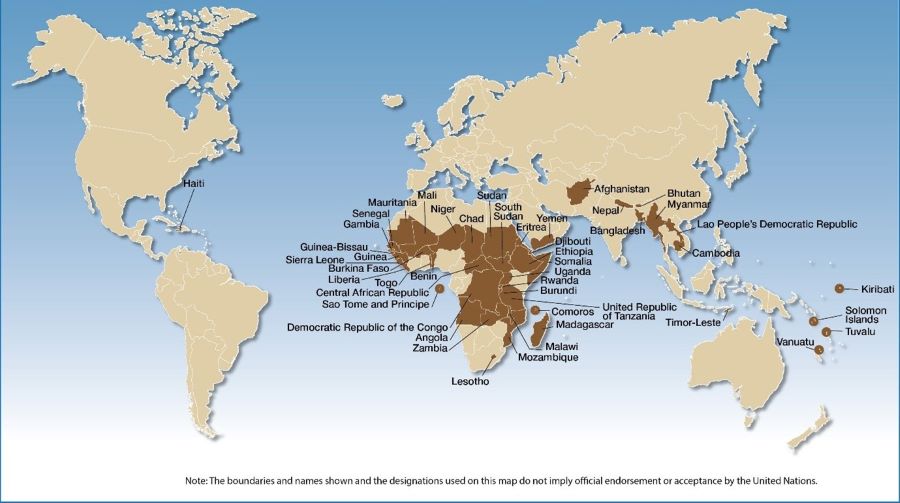There are 47 countries currently designated by the United Nations as least developed countries (LDCs), to which UNCTAD devotes its annual Least Developed Countries Report published today.. They are: Afghanistan, Angola, Bangladesh, Benin, Bhutan, Burkina Faso, Burundi, Cambodia, Central African Republic, Chad, Comoros, the Democratic Republic of the Congo, Djibouti, Eritrea, Ethiopia, Gambia, Guinea, Guinea-Bissau, Haiti, Kiribati, Lao People’s Democratic Republic, Lesotho, Liberia, Madagascar, Malawi, Mali, Mauritania, Mozambique, Myanmar, Nepal, Niger, Rwanda, Sao Tome and Principe, Senegal, Sierra Leone, Solomon Islands, Somalia, South Sudan, the Sudan, Timor-Leste, Togo, Tuvalu, Uganda, United Republic of Tanzania, Vanuatu, Yemen, Zambia.
This list is reviewed every three years by the Committee for Development Policy, a group of independent experts that reports to the United Nations Economic and Social Council (ECOSOC). In reporting to ECOSOC, the committee may recommend countries for addition to, or exclusion from (so-called “graduation” from), the list of LDCs.
The committee will use per-capita income, human assets and economic vulnerability criteria in its next review, scheduled to take place in February 2021 (see below). For all the three criteria, the committee uses different thresholds to identify the countries to be added to the category and those that graduate.
A country qualifies to be added to the category if it meets the addition thresholds on all three criteria and does not have a population greater than 75 million. Qualification for addition to the list effectively leads to LDC status only if the relevant country accepts this status.
A country typically qualifies for graduation from LDC status if it has met graduation thresholds under at least two of the three criteria in at least two consecutive triennial reviews of the list.
However, if the three-year average per-capita gross national income of a least developed country has risen to a level at least double the graduation threshold (i.e., $2,444), and if this performance is considered sustainable, the country is deemed eligible for graduation regardless of its score under the other two criteria.
The overall graduation landscape following the last review, conducted in March 2018, comprises:
- Five cases of graduation: Angola, Bhutan, Sao Tome and Principe, Solomon Islands and Vanuatu, which are scheduled to graduate as follows: Vanuatu (December 2020), Angola (February 2021), Bhutan (2023), Sao Tome and Principe and Solon Islands (2024);
- Two cases in which a decision by member States in ECOSOC has been deferred to no later than 2021: Kiribati and Tuvalu
- Two cases in which the Committee for Development Policy deferred consideration of the question of graduation to 2021: Nepal and Timor-Leste
- Three cases of pre-eligibility for graduation (and likely full eligibility in 2021): Bangladesh, the Lao People’s Democratic Republic and Myanmar
This means that as of 2020 there are 12 countries eligible or pre-eligible for graduation from LDC status, including one expected to graduate at the end of the year.
This graduation/qualification performance falls short of the vision expressed by the international community in 2011 of “enabling half the number of LDCs to meet the criteria for graduation by 2020”.
Five countries have graduated from LDC status since the United Nations devised the category in 1971:
- Botswana in December 1994
- Cabo Verde in December 2007
- The Maldives in January 2011
- Samoa in January 2014
- Equatorial Guinea in June 2017
UNCTAD’s annual Least Developed Countries Report provides a comprehensive and authoritative source of socio-economic analysis and policy recommendations on the LDC category.
|
The following three criteria will be used by the Committee for Development Policy in its next review of the LDC category in February 2021: · A per-capita income criterion, based on a three-year average estimate of the gross national income per capita, with a threshold of $1,018 for identifying possible cases of addition to the list, and a threshold of $1,222 for possible cases of graduation. · A human assets criterion, involving a composite index (the human assets index) consisting of two sub-indices: a health sub-index and an education sub-index. The health sub-index contains three indicators: (i) under-five mortality rate; (ii) maternal mortality ratio; (iii) and prevalence of stunting. The education sub-index contains three indicators: (i) gross secondary school enrolment ratio; (ii) adult literacy rate; and (iii) gender parity index for gross secondary school enrolment. · An economic and environmental vulnerability criterion, involving a composite index (the economic and environmental vulnerability index) consisting of two sub-indices: an economic vulnerability sub-index and an environmental vulnerability sub-index. The economic vulnerability sub-index contains four indicators: (i) share of agriculture, hunting forestry and fishing in GDP; (ii) remoteness and landlockedness; (iii) merchandise export concentration; and (iv) instability of exports of goods and services. The environmental vulnerability sub-index contains four indicators: (i) share of population in low elevated coastal zones; (ii) share of the population living in drylands; (iii) instability of agricultural production; and (iv) victims of disasters.
|
Figure: Least Developed Countries (47)
Africa 33, Asia 9, Caribbean 1, Pacific 4




